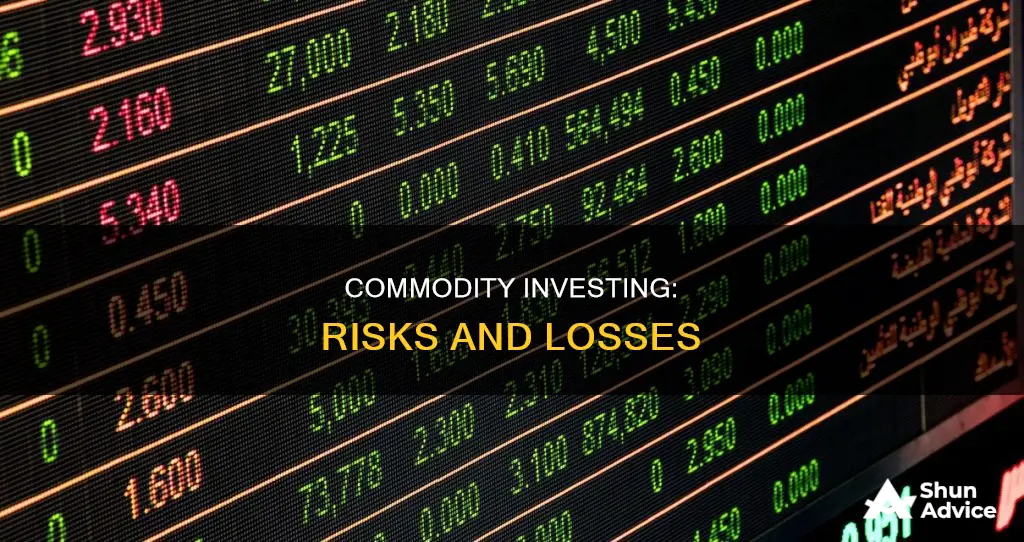
Investing in commodities can be a risky business, and there are several reasons why people lose money when investing in them. Commodities are raw materials that are either consumed directly, such as food, or used as building blocks to create other products. They include precious metals, oil, agricultural products and more. One of the main reasons people lose money is that commodities are highly volatile and complex investments. They are subject to unpredictable returns and are susceptible to significant price fluctuations due to various factors such as supply and demand, exchange rates, inflation, weather conditions, and the overall health of the economy. World events, import controls, worldwide competition, government regulations, and economic conditions can also impact commodity prices. For example, the Russian invasion of Ukraine in 2022 caused oil and natural gas prices to spike.
Another reason people lose money is that commodities are often speculative investments, where the sole focus is on profiting from the price of the commodity rather than the underlying cash flows. This makes the investment inherently risky as there is no guarantee of a profit. Additionally, commodities are usually highly correlated with other commodities, so a decline in one commodity can lead to a decline in others. For instance, if the price of oil rises, the value of an airline company may decrease as their profitability is impacted by higher fuel costs.
Furthermore, investing in commodities can be complex due to the diverse range of products, each operating according to its own specific supply and demand dynamics. For example, the factors influencing the price of gold may be entirely different from those affecting natural gas or livestock.
Finally, investing in commodities often requires a large amount of capital, and the companies producing commodities may require substantial investment to operate. This makes commodities a risky investment for those with a low-risk tolerance.
In summary, people can lose money investing in commodities due to their volatile nature, speculative focus, correlation with other commodities, complex dynamics, and the significant capital requirements involved.
| Characteristics | Values |
|---|---|
| Returns on commodities | Can be unpredictable |
| Commodities as a hedge against inflation | Commodity prices often follow inflation |
| Types of commodities | Hard commodities (gold, copper, aluminum, crude oil, natural gas, unleaded gasoline) and soft commodities (corn, wheat, soybeans, cattle) |
| Volatility | Commodities are one of the more volatile asset classes available |
| Speculative | If you’re hoping to profit solely based on the price of a commodity, then you’re speculating, not investing |
| Geopolitical events | Commodities are uniquely exposed to geopolitical events around the world |
| Weather | Commodity prices are also impacted by weather conditions around the globe |
| Concentration | Commodity investing often means that you have a large exposure to the price of a single asset |
What You'll Learn

Volatility
Commodity prices can be extremely volatile and are influenced by numerous factors, including supply and demand, exchange rates, inflation, economic conditions, and world events. For example, the weather can have a significant impact on commodity prices, as adverse conditions can affect the supply of agricultural commodities, causing prices to rise. Similarly, geopolitical events, such as the 2022 Russian invasion of Ukraine, can cause sudden spikes in energy prices.
The volatility of commodities is further exacerbated by the fact that they are often used as a hedge against inflation. As inflation rises, so do commodity prices, and this can lead to increased volatility. Additionally, commodities are typically classified as "hard" or "soft." Hard commodities, such as metals and energy products, tend to be more stable, while soft commodities, such as agricultural products, can be more volatile due to their dependence on environmental factors.
The high volatility of commodities can make them a risky investment. While it provides opportunities for speculation and potential profits, it also increases the chances of significant losses. This volatility is a key consideration for investors, and it is essential to understand the risks involved before investing in commodities.
To manage the risk associated with commodity investing, investors can consider diversifying their portfolio by investing in a range of commodities and other asset classes. Additionally, investing in commodity-related stocks or exchange-traded funds (ETFs) can provide indirect exposure to commodities while potentially reducing the impact of volatility on their portfolio. However, it is important to note that even these investment options can be significantly affected by commodity price volatility.
The NFT Investment Craze: Why?
You may want to see also

Speculation
Speculators play a crucial role in the commodities market by taking on risks that other market participants wish to avoid. They do not have any other stake in the asset besides betting on its short- and mid-term price movements. While speculation can lead to significant profits, it can also result in substantial losses. Speculators take on a high level of risk, and if the price of a commodity falls, they can lose a significant amount of money.
The line between speculation and investment can sometimes be blurry. Some sources define speculation as a higher-risk form of investment, while others view it more narrowly as positions not characterised as hedging. The U.S. Commodity Futures Trading Commission defines a speculator as "a trader who does not hedge but trades with the objective of achieving profits through the successful anticipation of price movements".
Overall, speculation in the commodities market is a complex and risky endeavour. While it can lead to significant profits, it can also result in substantial losses. Speculators play a crucial role in maintaining market efficiency, preventing shortages, and smoothing out price fluctuations.
Young Investors: Roth or Not?
You may want to see also

Geopolitical events
Conflict and War
Armed conflicts, whether regional or global, can disrupt supply chains, impact production and transportation of commodities, and lead to increased market volatility. For example, the 2022 Russia-Ukraine war disrupted energy markets and affected the prices of commodities such as oil and natural gas.
Trade Relations and Sanctions
Trade disputes, tariffs, and protectionist measures between countries can affect the supply and demand of commodities, impacting their prices. For instance, trade tensions between the US and China have led to structural changes in global supply chains, influencing investment decisions.
Political Instability
Political unrest, regime changes, and elections can create uncertainty in markets, causing investors to reevaluate their positions. This uncertainty can lead to short-term market volatility and impact commodity prices.
Currency Fluctuations
Sectoral Effects
Different industries are affected differently by geopolitical events. For example, defence and energy sectors may benefit from increased military spending, while export-oriented industries may suffer from trade disputes.
Long-Term Impacts
Some geopolitical events can have long-lasting effects on commodity investments. For example, the 1973 oil price shock, caused by the Arab oil embargo, depressed market returns over a prolonged period due to a sustained shortage of oil supply.
Commodity investors need to closely monitor geopolitical developments and assess their potential impact on their investments. Diversification, risk assessment, hedging strategies, and maintaining a long-term perspective can help mitigate the risks associated with geopolitical events.
Bahamas: Foreign Investment Origins
You may want to see also

Weather
Impact on Energy Commodities
The demand for energy sources like heating oil, natural gas, and gasoline is heavily influenced by weather conditions. During colder winters, people tend to use more heating oil and natural gas for warmth, leading to spikes in their prices. On the other hand, colder winters can also result in decreased gasoline usage as people drive less. This complex relationship between weather and energy consumption can create "extreme weather" in financial markets, as described by Daniel Hall, an assistant professor of economics.
Impact on Agricultural Commodities
Agricultural commodities, such as crops and livestock, are highly susceptible to weather changes. For instance, a freeze in Florida can cause a jump in orange juice prices, while warmer-than-expected winters can lead to higher crop production and a subsequent decrease in prices. Additionally, weather conditions like droughts, heat waves, and freezes can cause crop losses, affecting regional food production and commodity prices.
To mitigate the risks associated with weather variability, weather derivatives have gained popularity. These financial instruments allow businesses to hedge against weather-related losses. For example, energy companies can use weather derivatives to manage the risks of varying temperatures, which impact the demand and supply for their products. Similarly, farming businesses can enter into derivatives contracts to protect themselves from poor crop production due to adverse weather.
Overall Impact on Commodity Returns
In summary, weather plays a crucial role in shaping the performance of commodities, particularly in the energy and agricultural sectors. Its unpredictable nature can lead to volatile commodity prices, and investors must carefully consider weather patterns when making investment decisions in these sectors.
Rich People: Investing Secrets
You may want to see also

Concentration
Name Concentration Risk
Name concentration risk arises from uneven distribution or exposure to a single client, group of connected clients, or clients from the same region, sector, or with similar services and commodities. For example, investing heavily in a single commodity, such as gold, or a specific sector, like energy or agriculture, can lead to concentration risk. If the price of that commodity or sector experiences a downturn, the concentrated investment can result in significant losses.
Sectoral Concentration Risk
Sectoral concentration risk is associated with uneven exposure to particular sectors, regions, industries, or products. For instance, if an investor focuses primarily on commodities related to energy or natural resources, they are exposed to sectoral concentration risk. A decline in the energy market or environmental factors affecting natural resources can lead to losses.
Credit Risk Mitigation Techniques
The use of credit risk mitigation techniques can also introduce concentration risk. For example, if an investor relies heavily on derivatives or hedging strategies to manage their commodity investments, they may face concentration risk if these techniques fail to provide the expected protection or if the market moves against their positions.
Large Exposures
Indirect large exposures can lead to concentration risk. This occurs when an investor has significant indirect exposure to a specific commodity or sector through complex financial instruments or derivatives. For instance, investing in commodity-producing companies or exchange-traded funds (ETFs) that focus on specific commodities can lead to large exposures and, consequently, concentration risk.
To manage concentration risk, investors should diversify their portfolios, set thresholds for various types of risk, and monitor their portfolios frequently to identify areas of elevated risk. By doing so, they can reduce the potential impact of losses in any single investment area.
Investing in People: A Risky Business
You may want to see also
Frequently asked questions
Commodity prices can be extremely volatile and are susceptible to significant losses due to various factors, including supply and demand, exchange rates, inflation, economic conditions, and world events. For example, the COVID-19 slowdown in 2021 disrupted the supply of lumber, causing its price to soar temporarily.
Investing in commodities carries several risks, including volatility, speculation, geopolitical events, weather conditions, and concentration. These factors can cause substantial price swings, making it a speculative and risky endeavour.
While commodities are inherently risky, you can consider investing in stocks of companies that produce commodities. This way, you benefit from both the rise in commodity prices and the company's increased production over time. However, it's important to carefully analyse and understand the company and industry before investing.
There are several ways to gain exposure to commodities, such as purchasing physical commodities (e.g., gold), investing in exchange-traded funds (ETFs) that track commodity indexes, or buying shares of companies that produce or are heavily exposed to commodities. Each method has its own risks and considerations.







